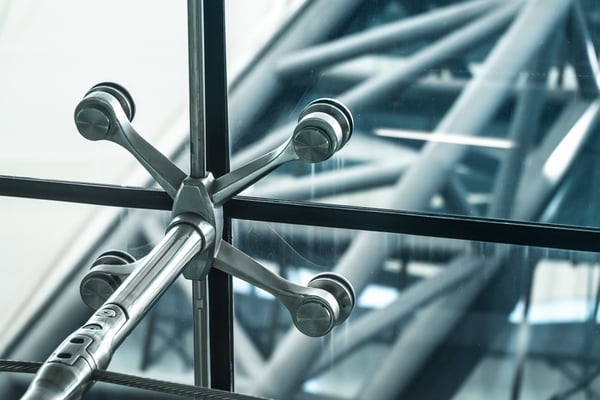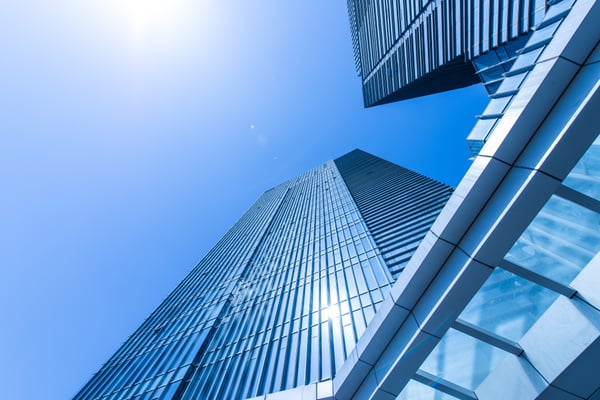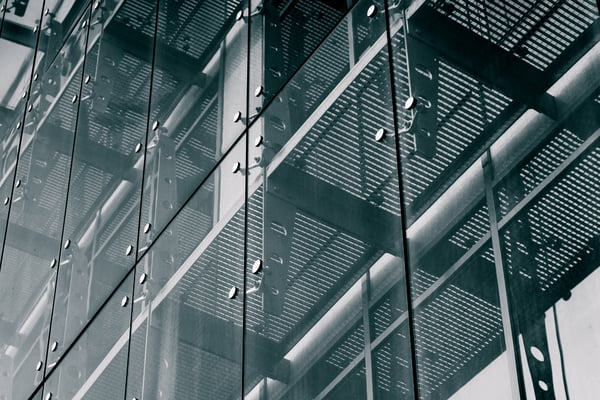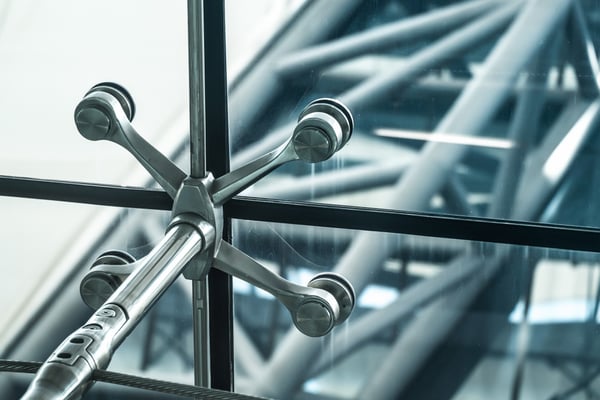A curtain wall is a non-structural system that covers the exterior of a building, with the aim of isolating the internal environment from external conditions. Curtain walls typically use an aluminum frame with glass infill, metal panels, or thin stone.
Thanks to their flexible design, curtain walls have become popular in skyscraper construction. This article provides an overview of the main design features of curtain walls.
Type of Rainscreen systems
Curtain walls use three types of rain protection systems: face-sealed, water-managed, and pressure-equalized.
Pressure equalized systems generally provide the greatest water resistance and air tightness.
- The inner faces of the glass, glass bag and wet seal are designed as an airtight barrier.
- On the other hand, the outer face of the glass, the outer glazing materials and the outer surface of the frame create a rain screen to drain water.
Improve energy efficiency with a high-performance building envelope.
Between the external rain protection and the internal hermetic barrier, a pressure equalization chamber is created in the glass bags. This reduces water penetration, eliminating pressure differences across the rain screen.
Water managed systems have no air barrier and some water penetration is inevitable. This water is controlled through drains and outflows inside the glass bag.
Face-sealed systems rely on continuous, complete seals between glass units and frames; these systems are not commonly used because the long-term reliability of the seals is questionable.
Structural Support

A curtain wall is designed to transfer any load to the floor structure below or to any intermediate structure. Curtain wall loads consist mainly of positive and negative wind loads, and there may also be snow, seismic or maintenance loads.
Curtain walls experience slight movements caused by temperature changes and wind loads. Therefore, all connections that anchor the wall must be designed to resist movement while also resisting and transferring loads.
Thermal performance
A curtain wall is part of the building envelope, affecting energy efficiency. The overall thermal performance of a curtain wall depends on the frame, glass infill, building area and perimeter details. The conductance of the curtain wall frame depends on the frame material, geometry and fabrication. For example, aluminum has a very high thermal conductivity. Thermal breaks of low conductivity materials are often incorporated to improve thermal performance.
Humidity control
Water can infiltrate the exterior wall system under the action of five different forces: gravity, pressure differences, surface tension, kinetic energy and capillary action. To control water infiltration, all these forces must be considered in the design.
Water resistance depends on glass details, frame construction, drainage details, caulking, frame gaskets, interior sealants and perimeter flashings. For a curtain wall to achieve an adequate level of water resistance, it must have adequate drainage to the glass pocket and a watertight frame construction.
Visual design

Curtain walls stand out in groups of buildings thanks to their unique glazed appearance. Among the main visual characteristics of a curtain wall are sight lines, defined as the visual profile of the horizontal and vertical mullions. The final appearance also depends on the width and depth of the curtain wall frame, and the depth of the frame in particular depends on the lateral load requirements.
Acoustics
The acoustic performance of curtain walls is determined by their glazing and internal seals. There are several methods to improve acoustic performance: using sound-attenuating fillers, making the system as airtight as possible, incorporating glass of various thicknesses or using noise-reducing layers such as polyvinyl butyral.
Back pans
Back pans are sheets of metal installed behind the opaque areas of a curtain wall, usually made from aluminum or galvanized steel. These elements provide a second line of defense against water infiltration, in areas of the curtain wall that are not visible from the inside.
Safety features
Smoke seals between the floor slab and the back of the curtain wall are crucial for fire protection. They divide walls into sections, slowing the movement of fire, smoke and combustion gases between floors.
Uncontrolled air and water leakage can lead to air quality problems. When water accumulates directly or through condensation, it can cause mold to grow. Many building materials are damaged by mold, and its spores can cause irritation and allergic reactions.
Durability

Like any other building element, curtain walls can deteriorate over time, especially when they lack proper maintenance.
Curtain wall glazing can become visually obstructed due to condensation or dirt, and opacifying films can be damaged over time by wear and condensation. Glass can also lose its insulating properties without adequate maintenance, increasing energy consumption in the building. The joints and sealants in a curtain wall can also fail due to wall movement, prolonged exposure to moisture and ultraviolet radiation.
Maintenance
Curtain walls and perimeter fences require planned maintenance to maximize their life cycle. When perimeter sealants are installed and maintained properly, they can last 10 to 15 years. Aluminum frames are protected with special coatings, which provide resistance to environmental degradation. However, these coatings must be cleaned properly at regular intervals.
Sustainability
The following are some best practices for making curtain wall systems more sustainable:
- Maximizing its useful life to reduce material waste. This can be achieved with professional design and installation, combined with proper maintenance.
- Design curtain walls with thermal breaks and high R-values to improve energy efficiency in buildings. Low-E glass coatings can significantly reduce heat gain in the summer and heat loss in the winter.
- In case of demolition, recycle materials such as aluminum and steel frames.
Since a curtain wall is part of the building envelope, it affects energy efficiency throughout its life cycle. A well-designed curtain wall can save a lot of energy in the long run by improving natural lighting and reducing HVAC loads.

